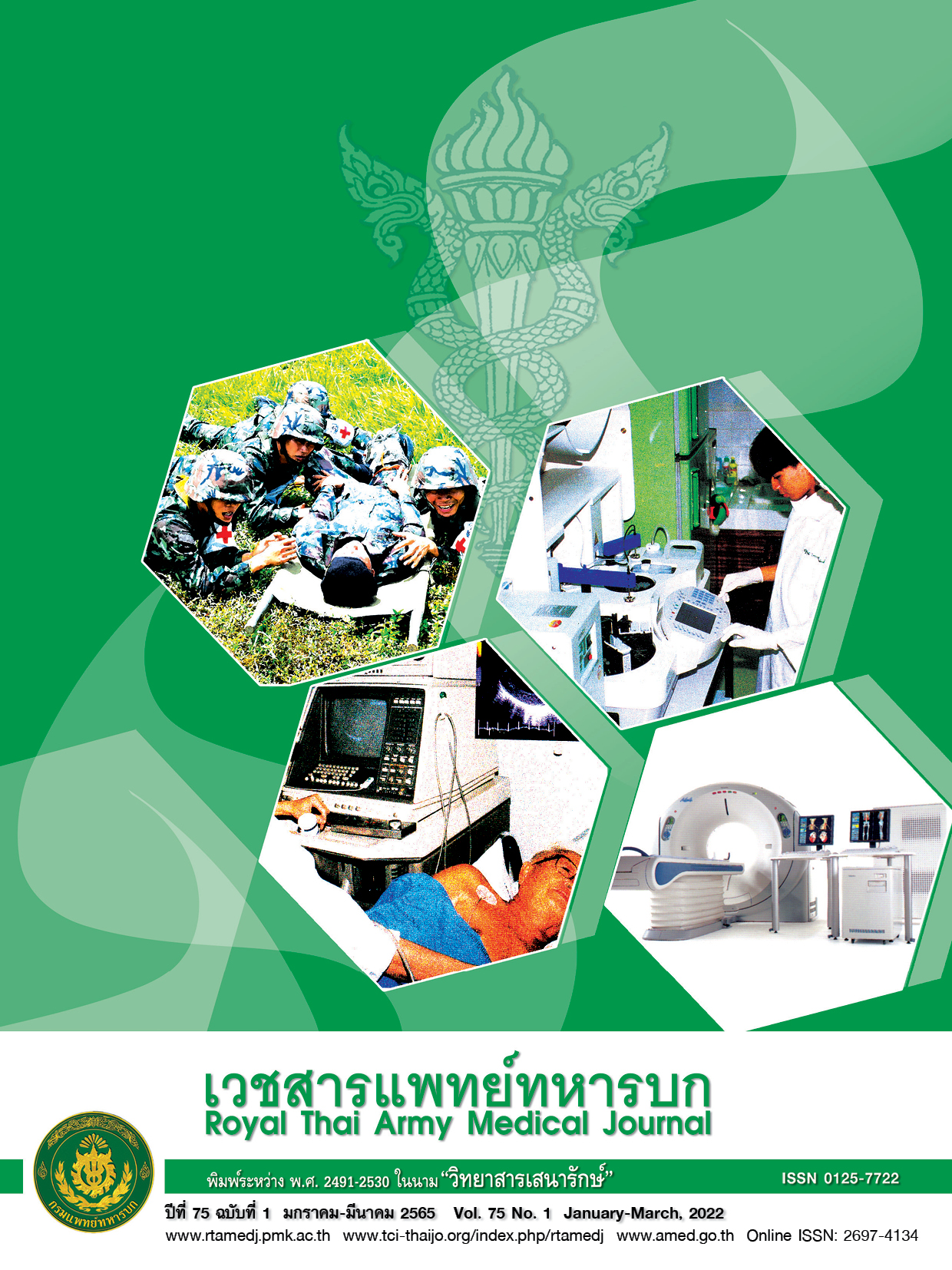การพัฒนาระบบส่งต่อผู้ป่วยโรคหลอดเลือดสมองผ่านระบบมือถืออัจฉริยะ (Stroke Man)
Main Article Content
บทคัดย่อ
บทนำ โรคหลอดเลือดสมองเป็นภาวะฉุกเฉินที่ต้องได้รับการรักษาอย่างทันทีและต้องมีระยะเวลาในการรักษาที่ต่อเนื่อง การมีเทคโนโลยีในการติดตามดูแลและส่งต่อผู้ป่วยจะช่วยให้การรักษาผู้ป่วยมีประสิทธิภาพมากขึ้น วัตถุประสงค์ เพื่อพัฒนาและทดสอบประสิทธิภาพระบบส่งต่อผู้ป่วยโรคหลอดเลือดสมองผ่านระบบมือถืออัจฉริยะ วิธีการ กลุ่มตัวอย่างได้แก่ บุคลการทางการแพทย์ที่ดูแลผู้ป่วยหอผู้ป่วยหลอดเลือดสมอง โรงพยาบาลเชียงรายประชานุเคราะห์จำนวน 18 ราย เครื่องมือที่ใช้ในการเก็บรวบรวมข้อมูลได้แก่ แบบสอบถามข้อมูลส่วนบุคคล แบบประเมินประสิทธิภาพความสมบูรณ์ของระบบ แบบประเมินความพึงพอใจของผู้ใช้งาน อัตราการครองเตียง วิเคราะห์ข้อมูลโดยใช้ร้อยละ ค่าเฉลี่ยและส่วนเบี่ยงเบนมาตรฐาน ผลการศึกษา ระบบส่งต่อผู้ป่วยโรคหลอดเลือดสมองผ่านระบบมือถืออัจฉริยะ (Stroke Man) เป็นระบบโครงสร้างฐานข้อมูลที่เชื่อมต่อกันตามสิทธิ์การเข้าถึงของผู้ใช้งาน โดยแพทย์ประสาทวิทยาและบุคลากรทางการแพทย์สามารถสั่งการใช้งานได้ทันที มีทั้งรูปแบบ Web-based Application ที่เชื่อมต่อข้อมูลกับระบบฐานข้อมูลและมีการใช้งานผ่านแอปพลิเคชันในระบบไอโอเอสและแอนดรอยด์ ประกอบด้วยข้อมูลการรักษาของผู้ป่วย แผนการรักษา แผนการกายภาพบำบัด และแผนการรักษาเมื่อส่งกลับไปดูแลต่อในโรงพยาบาลชุมชน ประสิทธิภาพและความพึงพอใจอยู่ในระดับมากที่สุด และระยะเวลาในการนอนโรงพยาบาลของผู้ป่วยภายหลังการพัฒนาระบบใช้เวลาในการนอนโรงพยาบาลน้อยกว่าก่อนอย่างมีนัยสำคัญทางสถิติ
สรุป ระบบส่งต่อผู้ป่วยโรคหลอดเลือดสมองผ่านมือถืออัจฉริยะสารถนำมาใช้ได้จริงและควรติดตามประสิทธิผลโดยการนำไปใช้ในกลุ่มตัวอย่างที่มีขนาดใหญ่และระยะเวลาในการติดตามที่นานขึ้น
Downloads
Article Details

อนุญาตภายใต้เงื่อนไข Creative Commons Attribution-NonCommercial-NoDerivatives 4.0 International License.
บทความในวารสารนี้อยู่ภายใต้ลิขสิทธิ์ของ กรมแพทย์ทหารบก และเผยแพร่ภายใต้สัญญาอนุญาต Creative Commons Attribution-NonCommercial-NoDerivatives 4.0 International (CC BY-NC-ND 4.0)
ท่านสามารถอ่านและใช้งานเพื่อวัตถุประสงค์ทางการศึกษา และทางวิชาการ เช่น การสอน การวิจัย หรือการอ้างอิง โดยต้องให้เครดิตอย่างเหมาะสมแก่ผู้เขียนและวารสาร
ห้ามใช้หรือแก้ไขบทความโดยไม่ได้รับอนุญาต
ข้อความที่ปรากฏในบทความเป็นความคิดเห็นของผู้เขียนเท่านั้น
ผู้เขียนเป็นผู้รับผิดชอบต่อเนื้อหาและความถูกต้องของบทความของตนอย่างเต็มที่
การนำบทความไปเผยแพร่ซ้ำในรูปแบบสาธารณะอื่นใด ต้องได้รับอนุญาตจากวารสาร
เอกสารอ้างอิง
Available from: https://www.world-stroke.org/about-wso/annual-reports
2. Bureau of Information Office of The Permanent Secretary of MOPH. MOPH news. [internet].
2563. [cited 2020 May 18]. Available from http://pr.moph.go.th/iprg/include/admin_
hotnew/show_hotnew.php?idHot_new=86419. Thai.
3. Arbour, R. Common neurosurgical and neurological disorders. In Morton, P.G., &
Fontaine, D.K. Critical Care Nursing: A Holistic Approach. (10thed). 2017: New York;
Wolters Kluwer.
4. American Heart Association [AHA], & American Stroke Association [ASA]. Guidelines for the
early management of patients with acute ischemic stroke. American Heart Association
Journal. 2013; 44: 870-947.
5. Health Administration Division. Guideline for intermediate care (service plan).
2020: Samutsakhon; Born to be Publishing.
6. Bussakorn L. Intermediated care service. [Internet] 2020 [cited 2020 May 18]
Available from: http://www.snmri.go.th/snmri/download/train/medical_f/
intermidiate.pdf. Thai
7. Stroke unit Chiangrai Prachanukroh hospital. Stroke patient statistic Chiangrai
Prachanukroh hospital 2560 -2562. 2562: Chiangrai. Thai
8. Junram S, & Samran R. Incidence of incomplete medical record for further examination or
advance treatment of Jainad Narendra hospital. Internet] 2020 [cited 2020 May 18]
Available from: http://www. chainathospital.org/chainatweb/assets/ research/
research26.pdf. Thai.
9. Maslow. A . A theory of human motivation Psychological .1943; New york: McGraw – Hill.
10.Peinjit B, Patthama A, Chidapha J, & Oraphan P. Effect of implementing computerized
perioperative nursing record program on quality of nursing records in surgical operation
unit. Rama Nurs J. 2013: 19(2); 249-63.


